Kitchen tables with tiles: features, types and tips for choosing
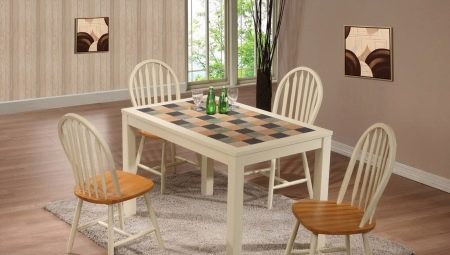
The kitchen table is included in the minimum set of functional items for a room designed for cooking and eating. And if you dispense with the formalities, then a table in the kitchen is an extremely necessary thing. If the area is small, you can abandon it in favor of a bar counter or a converted window sill (with a wide and often angular countertop).
But in most cases, standard options are considered, for which you can not only have lunch and dinner, but also cut food, roll out the dough and so on. In this case, it must be strong, stable and "not afraid" of scratches and pressure. This is the kitchen table with tiles.
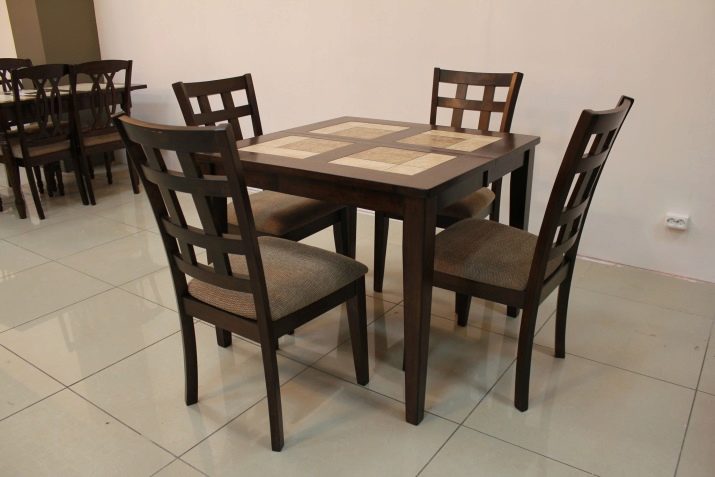
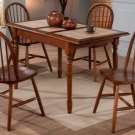
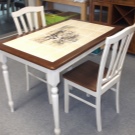
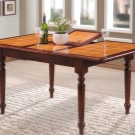
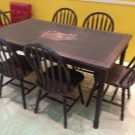
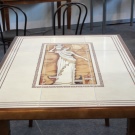
Advantages
The first and most important, but not always obvious advantage is the ability to build such a table on your own by restoring old, but still strong furniture.
If you have a suitable design from the “forever” series, but aesthetic notes have already accumulated for it, you can transform it with the help of ceramics.
And instead of the old table, you will get a new one: fashionable, very practical and durable.
Ceramic coating has at least 5 other advantages.
- A tile worktop is not only a dining surface, but also a work surface. If the kitchen set is not the most convenient for sculpting dumplings, making dough products, cutting salads, etc., then a table with tiles is quite suitable for such purposes.
- The coating itself is durable, durable and functional. If initially the table has high decorative qualities, then even over time, frayed tiles will not reduce them.The table is actually becoming a family value, and you don't want to change it to modern, but often faceless designs.
- The tile has excellent moisture resistance, and for the kitchen this quality is one of the most important. Any tree sooner or later begins to swell from moisture; this will not happen with tiles (or other coating options).
- Hot dishes can be placed on the cover, it is also “not afraid” of knife cuts.
- There is no need for additional table decor. Even without oilcloth, tablecloths, napkins, the furniture will look modern and self-sufficient.
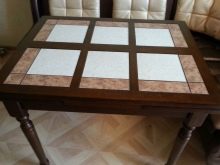
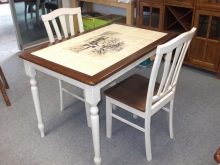
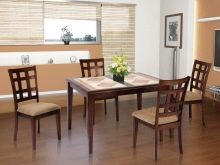
But you can still remember the fact that ceramic tiles do not absorb odors, do not leave stains after spilled liquid. She responds well to detergents, so caring for such a table will not cause difficulties.
disadvantages
It also does not do without minuses. For example, a ceramic countertop will make the structure heavier.
In everyday life, this will not create problems, but when you move, it will make you work hard.
Other disadvantages should also be mentioned.
- Seams between tiles, if they are even partly uneven, will accumulate dirt. And pretty fast. Their color, due to pollution, changes, the table loses its aesthetics.
- If a mistake is made in the technology of fixing the tiles, under the influence of loads it can crack. For example, this often happens when an oversized object falls.
- A ready-made ceramic table (not a home-made one) is not cheap.
Not the most convenient option is a folding table with tiles. It is easier to transform stationary options with ceramics that are not planned to be moved, transformed, etc.
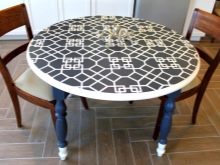
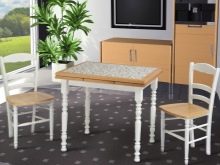
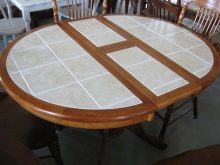
Ideas for transforming old furniture
Of course, it's easier to choose a new design in the store, pay and bring it to the kitchen. But it is still more interesting to participate in the creation of furniture yourself: choose, study restoration technologies, glue, align and enjoy the product of your creativity.
Attention! Very beautiful (almost designer) tables with mosaic tiles are obtained thanks to the transformation of the tabletop of an old sewing machine. For a very small kitchen, this is ideal, low-cost and exclusive.
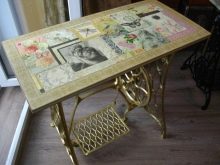

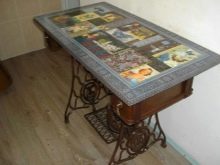
There are some more interesting ideas for making a table with your own tiles.
- If the kitchen has an island countertop, it can also be decorated and reinforced with tiles. It's great if it matches one of the interior elements of the kitchen. It is not necessary to "merge" it with the floor or walls; rather, it is better to make the covering accent. Roll call designs can be achieved by repeating the print of a lamp, a backsplash, or even a rug.
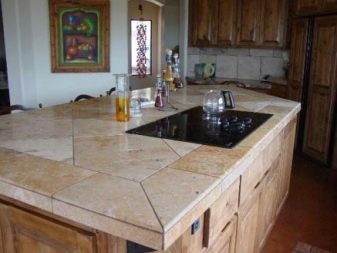
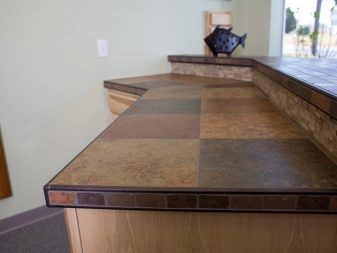
- The old grandmother's round table, as it turns out, may turn out to be stronger than modern ones. But the appearance requires a good "tuning". You can repaint the table in a trendy color (or neutral white), create fake scuffs, and lay out the countertop with large tiles or mosaics. You will get a luxurious thing that will magnetically attract households and guests.
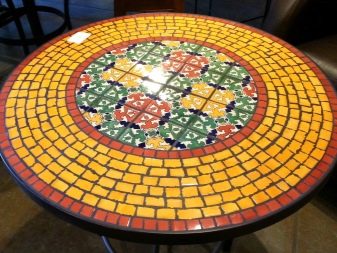
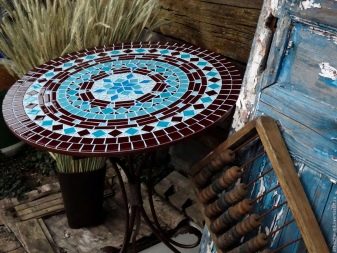
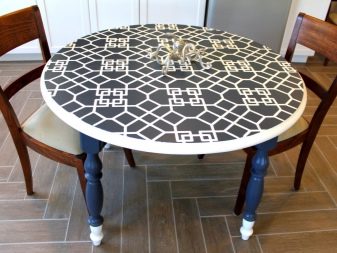
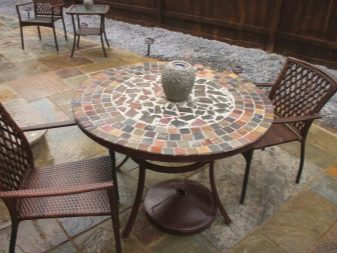
- Metal tables can also be decorated with tiles, this is quite an idea in the spirit of an inexpensive restaurant. Not suitable for every kitchen, but for atmospheric apartments with non-standard renovations - a cheap idea with an expensive result.

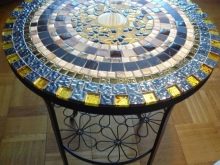
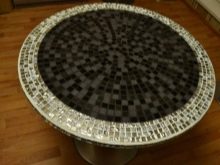
A sliding table is a little more difficult to decorate with tiles, but still possible. The main thing is to understand the design technology itself and to do all the "dirty" work as cleanly as possible.
How to do it yourself?
If you decide on such an experience, first arrange Internet surfing: evaluate the possible options, accumulate ideas, scroll through them in your head.
Workshops in video format, which explain step by step all the subtleties of the work, will also be useful.
In the standard case, to create a table with tiles, you will need:
- the base is usually an old table;
- Chipboard 19 mm thick or moisture-resistant plywood 12 mm (it is important that the material can withstand the weight of the ceramics);
- tile cutter;
- screwdriver;
- self-tapping screws;
- special glue;
- ruler and pencil for marking;
- putty knife;
- two-component epoxy grout for joints.
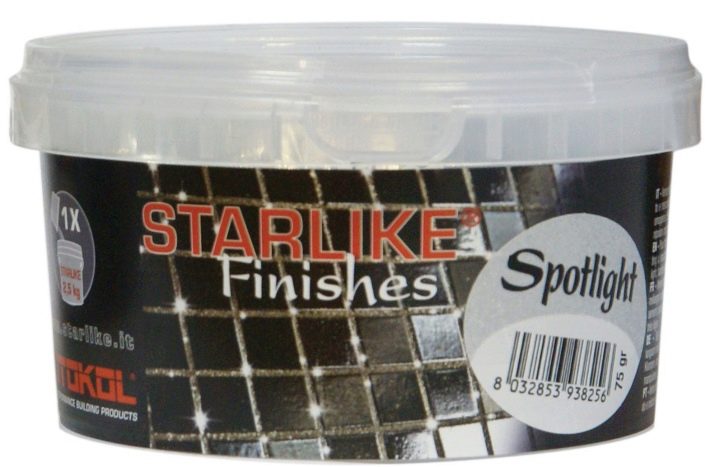
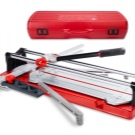
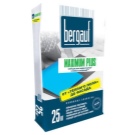

Finally, you need the tiles themselves. For a kitchen table, its minimum thickness must be at least 5 mm. Most preferred is the mosaic version, without large drops. Matte tile shades look more impressive than glossy ones.
Smooth tiles are also a priority and are easier to maintain. Large-sized material is not always suitable, but in order to accurately get into the proportions, you need to make a drawing of the table.
The decorating process consists of several stages.
- From the prepared base (plywood / chipboard), a workpiece is cut to the size of the table. It is screwed to the base with self-tapping screws. The ends are also closed with self-tapping screws.
- The base should be impregnated with a moisture protective agent, left to dry completely.
- After marking the middle lines on the surface, you need to start drawing the markings.
- The first tile, smeared with special tile adhesive, is laid in the center.
- The tile line should line up clearly with the line in the center of the table. Any shifts to the side will result in incorrect placement of all other elements. You need to control the installation using a level, the remnants of tile glue should be removed in a timely manner.
- Sometimes the tiles in the last rows have to be cut. If the edge is laid out with a mosaic of debris, you will not have to do this.
- After the tile adhesive has completely dried, grouting begins.
- Next, you should start decorating the ends. This can be done with wooden battens, beautiful corner pieces, decorative adhesive tape, or mosaic tiles.
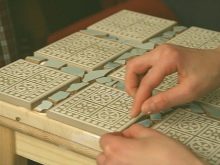
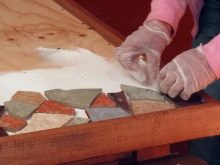

You choose the quality of the material yourself. Porcelain stoneware, ceramic or tiled tiles are suitable options that, with proper care, will really last a very long time.
Design nuances
The following questions are natural: "What kind of kitchen is such a table suitable for?" and "What if he turns out to be" alien "in the room?"
You still need to try to buy or make a table with a tiled surface, that will resonate with the overall design of the kitchen... Looking at the photo examples, you can see in which different spaces tables with tiles are used, how they can differ from the general color scheme and the materials that dominate the interior.
A bright tiled table is always a catchy, eye-catching detail. And such furniture has the right to be different, to remain self-sufficient. Therefore, such a table is often considered the starting point for creating an interior.
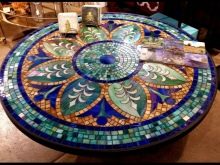
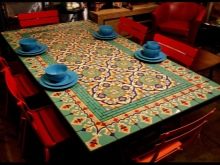
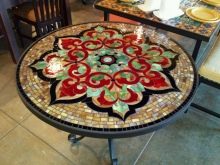
It is the beginning from which you need to build on the overall composition, the image of the kitchen. If there is such a table in the interior, you do not need to spend money on paintings and other large decor. The brighter the tiles, the more interesting the furniture and the space around it look.
There are different types of tables. Glossy ones require more maintenance and are not always able to create an impression of heirloom value, exclusivity. But matte tiles even transfer changes over time beautifully, from this the furniture only acquires, becomes vintage and solid.
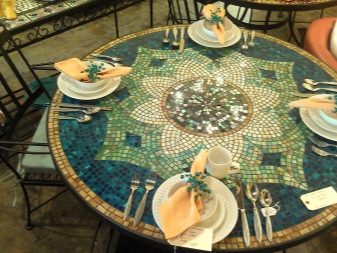
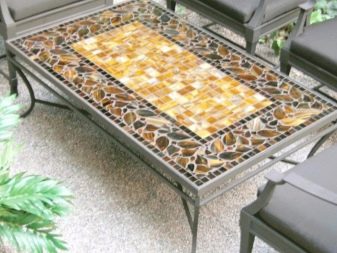
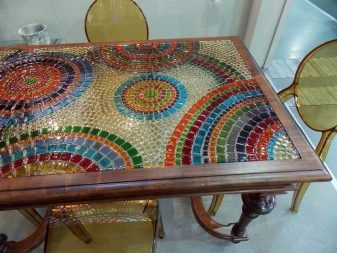
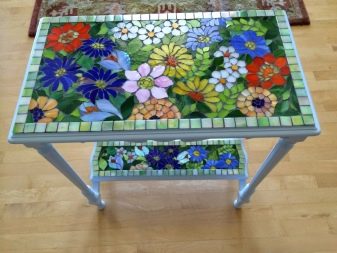
The shape of the table with tiles can be anything from a small square to a large round or oval.
If there are small children in the house, it is worth giving preference to furniture with rounded corners.
A table with tiles also solves questions of practicality, and answers decorative claims. With his appearance, the kitchen ceases to be boring, something solid and attractive appears on it. Perhaps this is what your kitchen lacked.
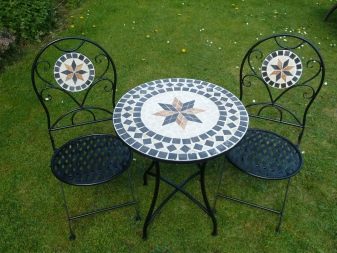
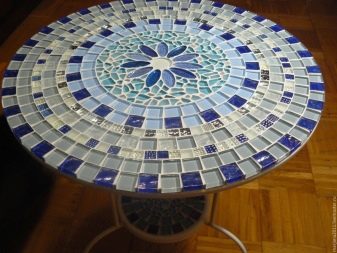
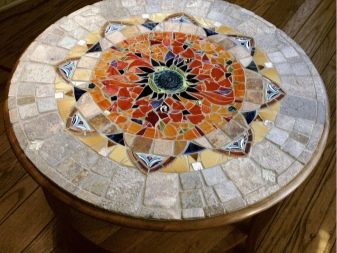
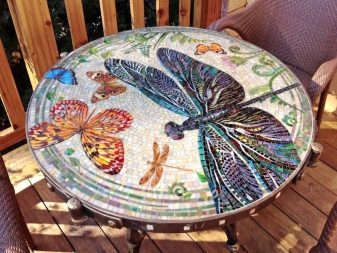
For tiling the table, see below.








